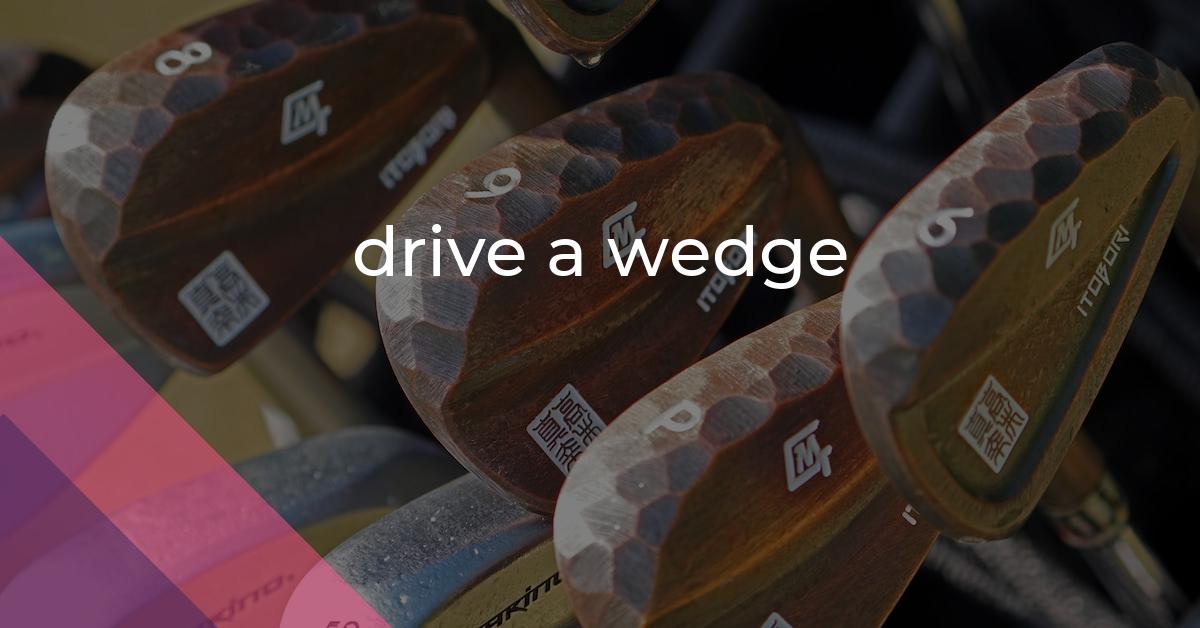drive a wedge: Idiom Meaning and Origin
What does ‘drive a wedge’ mean?
To drive a wedge means to create division or disagreement between people or groups, causing a rift or separation.

Idiom Explorer
The idiom "let drive" means to give someone free rein to do something or to allow them to act with full force or intensity.
"Lead on" means to encourage or persuade someone to believe or follow along in a course of action or idea, often deceiving them or giving false hope.
Grow apart means when two people or groups slowly lose their connection or drift away from each other emotionally or in terms of shared interests or goals.
"Flutter the dovecote" means to cause discontent or agitation in a group of people or disturb the peace and tranquility of a situation.
The idiom "fix someone's wagon" means to cause trouble for someone, often through punishment or retaliation, in order to teach them a lesson or seek revenge.
"Fan the flames" means to intentionally make a situation or conflict worse by increasing hostility or inciting more intense emotions.
The idiom "fall out" means to have a quarrel or disagreement with someone. It refers to a situation where two individuals no longer get along or have a conflict that causes distance or hostility between them.
The idiom "drive someone up the wall" means to irritate, annoy, or frustrate someone to the point of exasperation or anger.
The idiom "drive someone crazy" means to cause someone to become extremely annoyed, frustrated, or mentally unstable.
The idiom "drive out" means to force someone or something to leave a place or situation forcefully or aggressively.
For example, "The protestors were determined to drive out the corrupt politician from office."
Uncovering Hidden Symbolism
The idiom "drive a wedge" is an English phrase that conveys the idea of creating division or separation between people or groups. Its origin can be traced back to the 16th century, when the phrase first emerged in the carpentry and woodworking industry. Metaphorically, the idiom draws from the practice of using a wedge to split or separate objects, such as wood.
Derived from the physical act of driving a wedge into an object to create a gap or separation, this idiom is now used to describe actions or strategies aimed at creating division or discord within interpersonal relationships or groups. When someone says "drive a wedge," they are suggesting that a person or group is intentionally sowing seeds of disagreement or division in order to weaken the unity or resolve of another person or group.
One related idiom to "drive a wedge" is "drive a stake through its heart," which is used to describe actions taken to put an end to something, usually in a dramatic or conclusive manner. Just as driving a stake through the heart symbolizes the end of a vampire, driving a stake through a situation or an issue implies finality and resolution. In the context of driving a wedge, this related idiom can be used to emphasize the intent to completely destroy or eliminate unity or cooperation.
Another related idiom is "drive someone crazy," which refers to actions or behaviors that cause a person to become extremely irritated, frustrated or overwhelmed. This idiom highlights the psychological impact of actions aimed at creating division or separation. When someone drives a wedge between two people or groups, they can cause stress, tension, and ultimately drive them crazy.
Driving a wedge can be seen as a tactic used to undermine relationships, alliances, or agreements. It is often used in a negative sense, emphasizing the disruptive and damaging effects such actions can have on trust and cooperation. Whether in politics, business, or personal relationships, driving a wedge can lead to division and conflict.
In the political realm, driving a wedge refers to strategies employed to create divisions within a political party, coalition, or even a country. By highlighting existing differences or manipulating situations, individuals or groups can weaken the support or influence of a particular group or individual. This can ultimately lead to conflicts that hinder progress or cooperation.
In business, driving a wedge can be observed when competitors take actions to undermine the success or reputation of another company. This can involve tactics such as poaching employees, spreading negative reviews or information, or targeting a company's customer base. By driving a wedge between a company and its stakeholders, competitors can gain a competitive advantage.
On a personal level, driving a wedge can occur in relationships or friendships when one person intentionally tries to create discord or separation between two other individuals. Motivated by jealousy, resentment, or a desire to gain an advantage, a person may engage in manipulative behaviors that drive a wedge and cause tension between others. This can ultimately lead to the deterioration of relationships and loss of trust.
Ultimately, the idiom "drive a wedge" serves as a reminder of the damaging effects of actions or strategies aimed at creating division or separation. It emphasizes the importance of unity, cooperation, and trust in maintaining healthy relationships, both on a personal and societal level. By avoiding behaviors that drive a wedge, we can foster stronger connections and promote harmony in our interactions with others.
Example usage
Examples of how the idiom drive a wedge can be used in a sentence:
- She tried to drive a wedge between us by spreading rumors.
- The new policy is driving a wedge between the employees and the management.
- His constant criticism of her work is driving a wedge in their relationship.
More "Conflict" idioms



